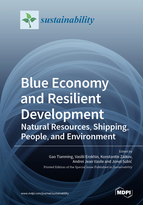Blue Economy and Resilient Development: Natural Resources, Shipping, People, and Environment
A special issue of Sustainability (ISSN 2071-1050).
Deadline for manuscript submissions: closed (31 May 2021) | Viewed by 53090
Special Issue Editors
Interests: economic development; industrial policy; investment; maritime economy; blue economy; China’s Arctic policy and developments; China-Russia and China-Nordic economic collaboration
Special Issues, Collections and Topics in MDPI journals
Interests: sustainable development; regional development; international trade; emerging markets, economies in transition
Special Issues, Collections and Topics in MDPI journals
Interests: international collaboration in the Arctic; sustainable exploration of Arctic resources; development of maritime routes in the Arctic Ocean
Interests: sustainable development; open economy macroeconomics; resource productivity
Special Issues, Collections and Topics in MDPI journals
Interests: sustainable development; bioeconomy; environmental economics; economic effectiveness of investments; strategic planning of local communities
Special Issues, Collections and Topics in MDPI journals
Special Issue Information
Dear Colleagues,
Ever since the ancient era, the blue economy has played one of the most important parts in mankind’s life and in assuring the resilient development of all communities involved. Oceans and seas cover over 70% of the Earth’s surface, constitute more than 95% of the biosphere, and provide a substantial portion of the global population with food and livelihoods. As the economic globalization has evolved in the past decades, the concept of the blue economy has been extended to include not only fisheries and marine products, but also extraction of mineral resources, intercontinental trade routes between major markets, cargo shipping and marine transport, energy production, tourism, and many other types of economic activity. As the oceans have emerged to become one of the global resource bases and transport corridors, it is crucial to identify the dangers that such a boom of human development activities may bring. In economic, social, and environmental terms, both the coastal territories and water areas are now changing at an unprecedented pace, in ways that fundamentally affect ecosystems, people, biodiversity, and sustainability. These transformations are likely to be felt globally, not only in coastal states. The most vulnerable regions include circumpolar territories (Arctic and Antarctic), the Atlantic Ocean (Northern Atlantic and the Mediterranean), and Asia (East, Southeast, and South Asia, the Pacific Ocean, and the Indian Ocean).
This Special Issue aims to address critical challenges to the blue economy in view of the growth in exploration and utilization of natural resources, transport connectivity, effects of climate change, sustainable fisheries management, food security, and social and economic issues of human well-being in coastal areas. In this context, this Special Issue supplements the existing literature by summoning political, economic, environmental, and social factors that influence various dimensions of the sustainable development of blue economy, as well as translating the findings into workable approaches and policies for the benefit of the economic actors, people, and environment. We welcome submissions from all areas of the blue and maritime economy, international relations, and social and life sciences with a high degree of novelty as full-length articles, reviews, and conceptual papers. Both theoretical and practical contributions that focus on topics related to the sustainable development of the blue economy are encouraged.
Prof. Tianming Gao
Dr. Vasilii Erokhin
Dr. Konstantin Zaikov
Prof. Andrei Jean Vasile
Prof. Jonel Subić
Guest Editors
Manuscript Submission Information
Manuscripts should be submitted online at www.mdpi.com by registering and logging in to this website. Once you are registered, click here to go to the submission form. Manuscripts can be submitted until the deadline. All submissions that pass pre-check are peer-reviewed. Accepted papers will be published continuously in the journal (as soon as accepted) and will be listed together on the special issue website. Research articles, review articles as well as short communications are invited. For planned papers, a title and short abstract (about 100 words) can be sent to the Editorial Office for announcement on this website.
Submitted manuscripts should not have been published previously, nor be under consideration for publication elsewhere (except conference proceedings papers). All manuscripts are thoroughly refereed through a single-blind peer-review process. A guide for authors and other relevant information for submission of manuscripts is available on the Instructions for Authors page. Sustainability is an international peer-reviewed open access semimonthly journal published by MDPI.
Please visit the Instructions for Authors page before submitting a manuscript. The Article Processing Charge (APC) for publication in this open access journal is 2400 CHF (Swiss Francs). Submitted papers should be well formatted and use good English. Authors may use MDPI's English editing service prior to publication or during author revisions.
Keywords
- biodiversity
- blue economy
- economic development
- environment
- investment
- maritime routes
- shipping
- sustainable development










